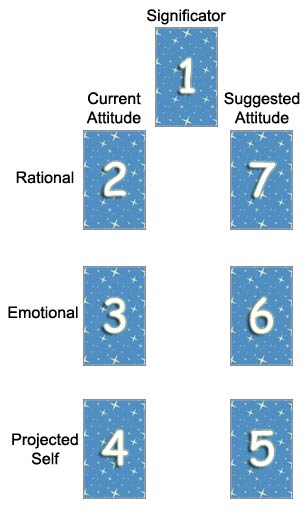The Path #1 is laid out in a grid utilising two columns and three rows.
The first of the three rows shows rational or intellectual thoughts concerning the question. The second row is concerned with emotional attitudes, meaning feelings. The bottom row represents your posture or stance, meaning how you project yourself outwardly, to the world.
The left column shows how you currently think, feel, and act regarding your concern. The right column suggests advice on how to change your attitudes on these three levels to provide the most beneficial outcome. The trick is to compare and contrast the two columns, which gives hints as to what the runes mean and how to make changes, small or large.

| Current | The Significator Gebo |
Suggested | |
| Thought |  Tiwaz |
 Isa |
|
| Emotion |  Ehwaz |
 Raidho |
|
| Posture |  Othala |
 Dagaz |
This sign suggests that your goals may be unrealistic at this time. Fortunately, these times will pass. Redouble your efforts or bide your time if you need to. Do not fight battles you know you cannot win. Be patient.
The Ice Rune represents stagnation and a cold, passionless reality. Your life may seem to be going nowhere at the moment, but if you persevere you will soon see better days.
Ehwaz reversed indicates boredom and restlessness. Although you may hunger for something different, do not act in haste. Wait patiently for the right opportunity to present itself.
This indicates there could be delays in reaching your goals. Be careful not to become disassociated from those around you. Remember to stay in touch with people.
Othala reversed represents chaos and hopelessness. A general lack of roots can even lead to homelessness. Take care of that which you have, or you could end up losing more than you can imagine.
Dagaz represents the first rays of a new dawn. You are on the verge of some kind of breakthrough. You have the will and the ability to change reality. You may experience a period of lucidity that borders on the surreal.